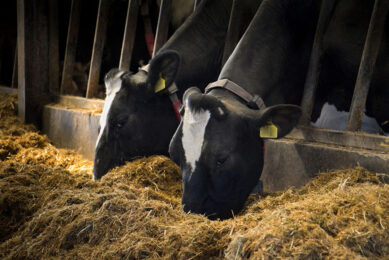Ingredient recognition in the United States

Legislation on registration of feed ingredients has become tighter after several past feed and food scares. In the United States a positive list is used for ingredients that are recognised as being safe. For novel ingredients it is not so easy to get on this list.
By Jarrod Kersey, Director of Ingredients & Legislative Affairs, AFIA, USA
Feed ingredients in the United States must be recognised by state and federal agencies. There are numerous reasons for this “positive list,” but primarily, it is to insure the safe use of ingredients in target species for a specific intended use. If a product being marketed is not officially “recognised,” then the ingredient or the product the ingredient is incorporated into may be subject to seizure. Therefore, firms must understand the US feed ingredient “approval” process if they wish to sell feed ingredients in the US.
The US Food and Drug Administration (FDA) is the primary federal agency responsible for the regulation of animal feed ingredients and plays a key role in ingredient recognition. The agency is responsible for “verifying” the safety of these ingredients for an intended use in a target species. However, while safety of an ingredient is paramount, a firm must first understand FDA’s classification of a “food” versus “drug.”
Food versus drug
According to FDA’s Center for Veterinary Medicine (CVM) , “US courts have interpreted food as something that provides nutrition, taste, or aroma. If a food affects the structure or function of the body, it does so by these properties (for example, a food may provide nutrients such as calcium for proper bone structure or taurine for healthy heart function in cats).”
Additionally, CVM notes “In the federal Food, Drug and Cosmetic Act adrug is, in part, an article intended for use in the diagnosis, cure, mitigation, treatment or prevention of disease, or an article intended to affect the structure or function of the body other than food (Sec. 201 (g)(1)).” It should be noted that in both of these definitions, the structure or function of the body can be impacted by either a food or a drug.
CVM also notes: “However, if a substance affects the structure or function of the body apart from its nutritive value, such as urine acidification or improvement in joint function, it may be considered a drug. Structure/function effects extending beyond thefoodumbrella also include claims for improved or increased production and performance, or alteration or improvement in function.”
Intended use
In seeking ingredient recognition, it is critical to understand the intended use of an ingredient must be food (to provide nutrition, taste or aroma).
FDA notes, “When a substance, including one considered food, is intended to be used for the treatment or prevention of disease ornon-foodstructure/function effect, FDA considers it a drug. Under the law, a new animal drug must be shown to be safe and effective for its intended use by adequate data from controlled scientific studies as part of a New Animal Drug Application (21 CFR, Part 514). If a product on the market is not approved, it may be deemed an adulterated drug and subject to regulatory action.”
That is, a food should not claim to treat, cure, prevent, mitigate or diagnose disease. Additionally, performance or feed efficiency improvement claims are typically deemed drug claims by FDA.
Therefore, FDA will typically view a product with an intended use for these purposes as a drug, not a food. Thus, when submitting ingredient information to FDA, it is critical a firm understands the need to establish data and submit information supporting the fact that the ingredient is indeed food.
Options for ingredient recognition
There are three options for ingredient recognition in the US:
1. Food additive petition process
2. Association of American Feed Control Officials Ingredient Definition (AAFCO)
3. Generally Recognised As Safe petition (GRAS)
(1) Food additive petition process
A food additive is defined in Section 570.3 of Title 21 as “e) Food additives includes all substances not exempted by section 201(s) of the act, the intended use of which results or may reasonably be expected to result, directly or indirectly, either in their becoming a component of food or otherwise affecting the characteristics of food.”
Based on the intended use of a food additive, it can be classified as one or more of the following: nutrient, aroma/flavour, taste, soluble or insoluble fibre, stabiliser, emulsifier, sequestrant, chemical preservative, anti-oxidant, anti-caking agent, etc.
To successfully petition for a food additive approval, each of the following must be addressed:
• Human food safety
• Target animal safety
• Environmental impact
• Utility
• Labelling
• Proposed regulation
• Assay methodology
• Manufacturing process and controls
(2) AAFCO ingredient definition
The AAFCO Official Publication outlines the process for Ingredient Definition Committee (IDC) ingredient approvals. From AAFCO’s beginning in 1909, the formulation of ingredient definitions was established as a cornerstone of the association. AAFCO’s defined objective was the “formulation of fair and equitable definitions, regulations and establishment of proper labelling requirements” with one of the Association’s purposes being “formulating and distributing a set of uniform definitions covering all feed ingredients.”
While not all feed ingredients have been defined (i.e. wheat gluten), AAFCO has made tremendous strides and the IDC process has become an important tool not only in North America, but throughout the world.
The process involves a petitioner, an AAFCO investigator, FDA and the IDC.
Petitioners can be any interested party who can propose a new definition (or amend an existing definition) while validating the need for this new definition and illustrating its safe use for the intended purpose.
There are a number of criteria a petitioner must address to propose a new definition, including: the rationale for the request, manufacturing details, use limitations, published literature, identification of possible contaminants, etc.
The petitioner works with the AAFCO investigator to insure all necessary information is provided, and then the proposed definition is shared with FDA in accordance with AAFCO and FDA’s Memorandum of Understanding. This MOU clearly outlines FDA’s role in the IDC process as a scientific adviser and further legitimises FDA’s recognition of AAFCO ingredient definitions. At this time, the investigator and a technical reviewer for FDA will determine the acceptability of the new or amended definition, and the petitioner will move the definition forward to the IDC chair if both parties agree. FDA’s primary concern is safety, and both FDA and AAFCO are concerned about technical accuracy for feed ingredient definitions.
If a new ingredient is proposed, reviewed and there are no safety concerns, FDA will likely render a no object letter, outlining a possible definition. However, FDA is less likely to get involved in a non-technical issue regarding an ingredient definition (i.e., what constitutes by-products).
(3) Generally recognised as safe procedure
The most recent form of ingredient recognition is the GRAS notification procedure in which a substance is generally recognised as safe among experts qualified to evaluate its safety under the conditions of its intended use. GRAS is also for an intended animal species.
The key difference between the GRAS procedure and the food additive petition or the IDC is two-fold.
First, for a substance to be GRAS, there must be “general recognition” of safety. That is, the firm developing a GRAS petition should understand that for an ingredient to meet the criteria for GRAS, it must be “generally recognised,” meaning there is available public literature regarding its safety for an intended use in a target species.
Second, in the GRAS system, it is the firm that affirms the product is safe, and not the agency. In both the food additive petition and AAFCO IDC processes, the firm must submit data, but it’s FDA’s final determination regarding safety that ultimately results in the approval of a food additive or AAFCO ingredient definition. In the GRAS process, the FDA will issue a “no questions asked” letter if a firm has addressed all potential safety concerns in its submission.
Finally, the process of ingredient recognition is typically dependent upon the potential safety concerns. An ingredient with the highest level of concern would likely be directed towards the food additive petition process, while an ingredient with fewer safety concerns would be directed through the AAFCO IDC process. Ingredients posing the lowest hurdle for affirming safety (due to general recognition) could utilise the GRAS option for ingredient recognition.
Conclusion Firms wishing to market feed ingredients in the US must understand an ingredient should be recognised by the FDA, and there are three ways to achieve this. In order to successfully navigate the ingredient recognition process, firms must understand the FDA’s differentiation between food and drug. Based on the available safety data, history of use, and potential safety concerns, a firm will utilise one of these processes for ingredient recognition: the food additive petition, the AAFCO ingredient definition process and the GRAS notification procedure. |
Source: Feed Tech Volume 13. 6











